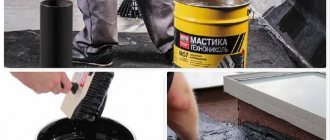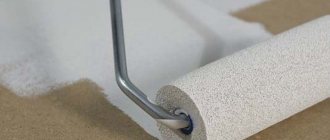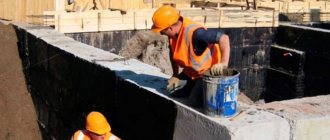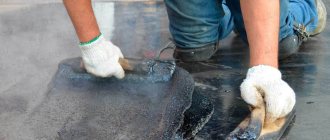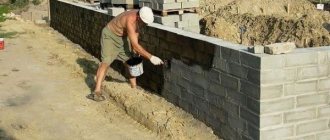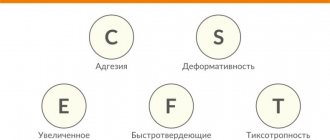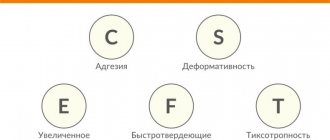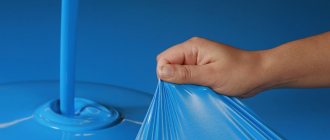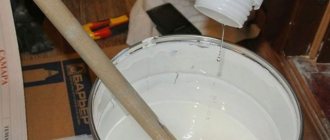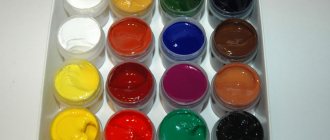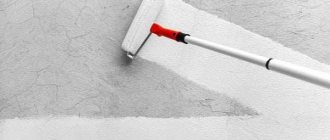Bitumen is one of the oldest waterproofing materials. This is not an exaggeration - it was used in Mesopotamia and other ancient states. But in its pure form, bitumen is short-lived: after hardening, it becomes brittle, cracks when the temperature changes, and cannot withstand point loads—it is enough to step on the bitumen coating unsuccessfully to damage it and break the tightness. Therefore, instead of pure bitumen in modern construction, compositions based on it are used for waterproofing - bitumen mastics. After hardening, they provide a durable and elastic coating with a service life of up to 25 years, and in some cases even more.
What is included in bitumen mastic
The mastic is based on modified petroleum bitumen (black resin) with the addition of technological additives that give the composition special properties: resistance to low temperatures, high fluidity, etc. Externally, it is a pasty plastic substance of a very rich black color. In addition to the bitumen base, the composition contains:
- Inclusions that ensure the hardness of the material: special mineral wool, ash, dusted asbestos, brick, quartz or limestone powders.
- Thickeners that guarantee ease of application of the composition: ground asbestos, peat chips, chalk.
- Special fiber fillers. They serve as reinforcement and make the substance resistant to bending.
Technology for applying bitumen mastic
If we consider the initial composition of mastics, we distinguish the following types:
- Regular or unmodified. They do not contain improving additives, so they are not used for application to roofing. They are used for structures that are operated in conditions without temperature changes and heating.
- Bitumen-polymer. These are just bitumen roofing mastics that can withstand all the impacts to which the roof is exposed, and also provide a high degree of adhesion between the roll coating and the roof base.
- Bitumen-rubber. Their main feature is the presence of anti-corrosion properties. Due to this, they are optimal for protecting metal structures.
- Rubber based on bitumen, or so-called liquid rubber. Of all types, this is the best bitumen mastic for roofing , since it has good mechanical and physical characteristics and excellent elasticity.
What does a roof covered with bitumen mastic look like?
Another component is the solvent. Based on this, mastics are distinguished:
- water based;
- with the addition of organic solvents;
- with liquid organic substances.
Bitumen mastic is a ready-made roofing material that does not require dilution. Immediately after purchasing the composition, you can begin work, unlike bitumen, which previously had to be heated before use.
Please note: in some cases, the mastic is pre-mixed with a hardener - this applies to two-component compositions. It is very important to follow the proportions recommended by the manufacturer, otherwise the mixture will be spoiled.
Main application in construction
Knowing why bitumen-based mastic is needed will help you understand how to use the composition. The product is used for many types of construction work. The most popular ones are working with the roof, floor, foundation and walls. The specifics of the application will be discussed below.
The most popular ones are working with the roof, floor, foundation and walls.
For roofing
It can be used for repairing and finishing roofs in a variety of ways; the product is suitable for any type of roof and can be used as an adhesive for roll waterproofing. Also as an independent protective layer. The composition gives an even coating that does not allow water to pass through. It can also be used to repair a leaky roof.
Sometimes you can apply the product without removing the old finish.
The product is suitable for any type of roof.
For the foundation
To treat the foundation, rubber-bitumen mastics, as well as polymer ones, are better suited. The use of rubber composition is allowed. The product can be used to carry out waterproofing work on concrete foundations, as well as for structures buried in the ground, creating a layer that reliably protects the material from moisture.
To treat the foundation, rubber-bitumen mastics, as well as polymer ones, are better suited.
For floor
A special mastic can help protect the floor, which will create enhanced protection against moisture; its use is popular when working with bathroom floors. Such products do not emit unpleasant odors, so they are suitable for interior work. Can be used when working with parquet, linoleum, other wooden floor coverings, and for concrete bases.
A special mastic can help protect the floor, which will create enhanced protection against moisture.
For wall decoration
When you need to protect walls in rooms with high humidity, you can also use a cold type of mastic. Most often it is chosen for work in basements and on ground floors.
When you need to protect walls in rooms with high humidity, you can also use a cold type of mastic.
Main types of bitumen mastic
The main criterion for classifying mastics is the method of application. Although they were developed as an alternative to bitumen, which requires heating, it was not possible to completely avoid this step. Thus, there are compositions for hot and cold use.
Applying bitumen mastic to vertical surfaces
Hot application
Hot bitumen mastics have a more complex application technology. Before starting work, they require heating to 150 °C, and therefore are rarely used today. It was these mastics that were the first to be produced instead of bitumen. Now they have practically been abandoned, but they are still present in species. They are used to glue rolled materials and individual parts of multi-layer roofs.
The hot composition should not be applied to vertical elements, since it spreads easily due to heating. The applied layer is 2 mm. The advantages of hot-applied mastics include:
- Formation of a very durable outer coating.
- Absolutely no shrinkage after application.
- Increased degree of elasticity.
Cold application
bituminous waterproofing mastic has a wider scope of application, since it does not simply spread over the surface, does not require heating, and is therefore ready for use. Solvents are used to control the thickness of the composition. Cold mastics do just the job when you need to provide waterproofing on inclined and vertical elements.
What is important to know about such compounds:
- Safe against fires and burns as they do not require heating.
- Approved for use at low temperatures (but here drying will take a little longer).
- In addition to coating waterproofing, they are also widely used as an adhesive base for connecting layers of roofing carpet.
- Optimal for filling expansion joints.
- Much more convenient and easier to use than the hot composition.
If work is carried out at low temperatures, then the cold-applied mastic also needs to be heated first, but to 30-40 °C.
Please note: after diluting the mastic with solvents, it is important to use it immediately. The composition cannot remain in a diluted state for a long time, since its components quickly push out the liquid and become viscous again.
Types of compositions
Mastic is divided into types according to its properties included in the components.
Visual effects are achieved depending on the type and size of the aggregate.
Waterproofing
The waterproofing agent is divided into hard, plastic, and elastic. Based on the speed of drying, they are divided into quick-drying, drying, and non-drying.
This material is easy to apply and use, which reduces the time spent on waterproofing work. Another positive side is its accessibility.
It is worth considering additives from natural and organic resins, synthetic additives, natural rubber, additives.
When using the hot bitumen waterproofing method, the resin is spread in a liquid state over the plane using a rope mop.
With this method, strict adherence to safety precautions is necessary!
Before use, bitumen pieces are heated to the melting point. At the same time, all the inherent insulating qualities of the material begin to appear.
Heating produces a strong odor and soot. Which makes breathing difficult and costs extra for cleaning. There is also a danger of burns, which require long-term treatment.
If extensive work is carried out, then constant heating of the material is required, otherwise after time it will become viscous again and then harden.
For cold waterproofing, ready-made bitumen mixtures are used. Work is carried out on a dry, cleaned surface.
Comparative table of properties of bitumen and mastics for various applications
| Cold solvent-based mastic | Cold water-based mastic | Hot mastic | Bitumen | |||
| Options | Roof | Foundation | Roof | Foundation | Roof | Foundation |
| Thickness of 1 layer, mm | 1,0 | 0,5-1,0 | 1,0 | 0,5-1,0 | 2,0 | 1,0 |
| Consumption per 1 layer, kg/m2 | 1,0-2,0 | 1,0-1,5 | 1,5 | 1,0-1,5 | 2,0-2,5 | 1,0 |
| How long does it take to dry at 20 °C and 50% humidity, hours | 24 | 24 | 5 | 5 | 4 | 24 |
| Temperature at which work can be performed, °C | -10 to +40 | -10 to +40 | From +5 to +40 | From +5 to +40 | From +5 to +40 | From +5 to +40 |
| Base humidity no more than, % | 4 | 4 | 8 | 8 | 4 | 4 |
Consumption
The consumption of rubber bitumen composition varies depending on the type of work. When gluing roofing felt, this is approximately from a quarter to a liter per square. If a mastic roof with a thickness of one cm is being constructed, then approximately 16 kg per meter will be needed.
If you are waterproofing a basement or wall in one layer, then you need approximately 5-6 kg of bitumen-latex composition per square meter. When mastic roofing is performed, 3 or 4 layers will be required, so the consumption will be up to 14 kg per meter.
Waterproofing with bitumen-oil mastic in one layer requires up to 1.5 kg of composition per meter. The number of layers of roofing mastic depends on the angle of its slope. A reinforcing layer is required - it will strengthen places where moisture is likely to accumulate.
Scope of application of bitumen mastics
Structures on which bitumen mastic can be applied:
- On flat and pitched roofs, including when covering some areas with bituminous shingles.
- Foundations, pipelines, concrete surfaces, terraces.
- Swimming pools, fountains, artificial reservoirs.
- Floor and covering slabs for rough screed or self-leveling, as well as for floors in garages, basements, and bathrooms, slabs for loggias and balconies.
Applying bitumen mastic to the roof
Mastic is used when installing soft tiles or rolled materials on the roof. In such cases, the material plays the role of an adhesive composition. You can lay glass insulation, roofing felt and other similar materials on it.
Gluing rolled materials onto mastic
Please note: the roof on which it is planned to use bitumen mastic can consist of absolutely any materials, including concrete, roofing felt, tiles, slate, metal tiles, etc.
If the composition includes latex, rubber or caoutchouc, mastic can be used as a roof covering. Very often, it is used to repair old roofs, and also glue polystyrene foam to the foundation.
We recommend studying in more detail: “The whole truth about polystyrene foam: characteristics, pros and cons, degree of flammability and safety.”
Liquid bitumen in road construction works
When creating asphalt road surfaces, liquid bitumen is often used.
To ensure that the coating has a long service life and is not exposed to adverse factors, only high-quality mixtures are used for work, to which special requirements are applied.
The peculiarity of liquid bitumen compositions is that they must be used as quickly as possible.
Liquid bitumen is indispensable when carrying out road repair work, laying asphalt pavements in the cold season, and processing gravel and crushed stone mixtures. The disadvantage of bitumen compositions is the loss of strength under the influence of high pressure and temperatures.
To improve the properties of road surfaces, plasticizers, modifiers, and other additives are used when laying asphalt. The choice of brand of bitumen mixtures depends on climatic conditions and the maximum permissible load.
Delivery of liquid bitumen to the work site is carried out in special bitumen trucks. Warming up to the desired temperature ensures the required consistency of the material.
Bitumen, packaged in metal containers, is convenient for use and storage. Hermetic containers protect compounds from the harmful effects of adverse external factors.
Advantages of bitumen mastic over roll waterproofing
Mineral fillers in bitumen mastic for waterproofing increase the amount of non-volatile substances to approximately 65% by weight. This ensures that the treated surface is completely sealed and will not depressurize due to evaporation of the protective layer. Other advantages of bitumen mastic include:
- No seams that could lead to leakage.
- The ability to hide minor defects and level the surface.
- Ideal adhesion ability that eliminates peeling and swelling of the material.
- No tendency to cracks.
- Can be applied to rust, paint and even old roofing.
- Long service life - 25-30 years.
- High tensile strength - even at joints, the coating will not separate or tear due to mechanical loads or temperature changes.
- Very simple application technology.
- Almost complete absence of additional load on the roof.
- The ability to obtain a composition of any thickness by adding solvents.
Basic properties, parameters of liquid bitumen
Liquid bitumen is a plastic, viscous building material. An increase in temperature leads to its softening and increased plasticity, which makes it possible to use bitumen mixtures in the process of carrying out a number of construction works.
To make the building material suitable for use, it is enough to warm up the liquid bitumen a little. Application, video, and other information about the properties and characteristics of this type of building material can be viewed below:
The main characteristics that determine the properties of bitumen include:
- Ducility (extensibility) – determines the degree of plasticity of bitumen compositions.
- Penetration is a value that determines the viscosity and level of hardness of a material.
- Thermal stability. This parameter determines the softening temperature of bitumen masses, the transition of bitumen to a brittle state.
Liquid bitumen belongs to the group of building materials with a high level of adhesion. In addition to plasticity, viscosity, melting temperature, the operational characteristics of the material are determined by such a parameter as the brittleness temperature at which the first crack appears in the bitumen layer.
Subject to the correct installation technology and certain conditions, bitumen adheres as firmly as possible to the base of any surface.
After hardening, it is almost impossible to remove using available means, which explains not only the high quality and reliability of the building material, but also indicates that all work is recommended to be carried out with maximum responsibility, adhering to the established technology. The consumption of liquid bitumen depends on the condition, properties, and configuration of the surfaces being treated.
After applying the bitumen mixture to the surface to be treated, the thickening process of the bitumen mass occurs due to the evaporation of oils that are present in the structure of the material, which leads to its complete hardening. Regardless of the strength of mechanical influences, the material is not subject to deformation and is not sensitive to other environmental factors.
The main advantages of liquid bitumen include:
- simplicity, ease of use
- high quality and performance parameters
- waterproof
- frost resistance
- low electrical conductivity
- high degree of thermal expansion
- excellent waterproofing, hydrophobic properties
- affordable price
- high level of adhesion, regardless of the substrate being processed
Liquid bitumen does not require heating before application and increases the durability and wear resistance of coatings. Laying bitumen mixtures can be carried out on porous surfaces.
The use of liquid bitumen allows you to increase the time required for construction and road repair work.
The biochemical composition, unique structure, and physical and chemical properties of the material allow work to be carried out in winter, during the cold season. On the modern building materials market there are various brands of liquid bitumen, which differ in their structure, which allows you to select building materials taking into account specific conditions, type, and specifics of the work performed.
Does mastic have any disadvantages?
There are not many disadvantages of bitumen mastics. And even the existing disadvantages are more of some limitations in application that are encountered in rare cases. So, among the disadvantages there are:
- The need to apply on a flat surface, otherwise the liquid substance may flow to one side. To reduce the fluidity of the substance, thickeners and cement are used. It is important to carefully prepare a surface with pits and tubercles and smooth out all defects.
- Cannot be used during rain. Water-based mastics also cannot be used at subzero temperatures.
- Difficulties in controlling the thickness of the applied layer, which may increase the consumption of bitumen mastic .
General technology and rules of application
The very first step in creating roof waterproofing is thorough cleaning of the base. The old coating is removed from it, all debris is removed and dust is removed. Next, apply a bitumen primer to a clean, dry base. To do this you will need a regular paint brush.
Very important: do not skip the step of cleaning the base under any circumstances, since without preparation it can be very difficult to create a layer of approximately the same thickness.
To apply cold mastic, use spatulas, rollers or brushes. This method is quite expensive, since it is more difficult to control the thickness of the layer.
Manual application of bitumen mastic
With the mechanized method, a special airless sprayer is used, which supplies the composition under a pressure of 150 bar.
Mechanized method of applying mastic
Important: the sprayer must have the function of mixing components inside the unit.
How to apply mastic correctly:
- Before starting, if necessary, warm the composition at room temperature, leaving it indoors for one day.
- Using the instructions, add solvent to the mastic and mix everything thoroughly.
- After cleaning the base and treating with primer, dry the roof.
- Pour a small amount of the mixture onto the roof and spread the mixture using a mop or scraper.
Please note: to increase the strength of the resulting waterproofing, you can lay a reinforcing mesh on the roof surface, and only then apply mastic.
To repair a metal roof, you need to clean it from oil stains, rust and organic contaminants, and then apply mastic in 2 layers, preferably with a coarse wide brush. It is also necessary to coat all passage elements and their joints with the roof with the composition.
Treating the junctions of elements with the roof with mastic
If local repairs to the roofing are necessary, then simply cut the swollen area crosswise, then bend the edges and apply a sufficient amount of mastic under them. Next, all that remains is to press the edges back. If necessary, you can additionally place a reinforcing mesh on the damaged area.
Local repair of roofing covering with mastic
Useful tips for effective use of mastic:
- When processing vertical planes, several layers are made.
- In order for the composition to adhere well, it is worth applying it from bottom to top in parallel stripes to the very top of the structure.
- For better mixing, you can use a drill with a special mixer attachment.
Applying mastic
To understand how to process different surfaces, it is worth knowing some subtleties. To treat the foundation with your own hands, it is better to choose a cold type of product; the tools used are a spatula and a brush. You can also use an automated method.
When processing floor coverings, the instructions require that you first apply priming to the surface. The product must be applied to the roof with a hard brush; for the protective effect of mastic patches on the roof, sand is poured onto them. If you choose a mastic solution for gluing rolled material, then after application it is rolled out over the mastic and leveled on the surface.
The manufacturer writes on the packaging how long it takes for the mastic to dry; you should carefully study the instructions.
To treat the foundation with your own hands, it is better to choose a cold type of product.
Bituminous mastic has a large number of positive qualities; the invention of the cold type helped to increase the scope of application of the composition, and it became possible to apply it yourself, saving on the services of professionals. It is only important to choose the right type.
Which bitumen mastic to choose
The domestic market offers a particularly wide range of bituminous mastics. It has been a leader in the production of insulating materials for many years. TechnoNIKOL bitumen mastics are presented in a large assortment:
- Mastic No. 21 “TECHNOMAST”. Universal because it is suitable for any type of roof. It is also allowed for use on building structures and metal surfaces. It is based on bitumen modified with artificial rubber.
Mastic No. 21 “TECHNOMAST”
- Adhesive mastic No. 23. Designed specifically for flexible tiles for gluing to any surface.
Adhesive mastic No. 23 "TechnoNIKOL"
- Mastic MGTN No. 24. Designed for waterproofing structures that come into contact with a damp environment and are buried in the ground.
Mastic MGTN No. 24
- Mastic No. 27. Designed for gluing extruded polystyrene foam to insulating materials, wood, metal and concrete surfaces.
Mastic No. 27 "TechnoNIKOL"
- Mastic No. 57. A special composition for protecting roofing coverings from corrosion, heat and ultraviolet radiation.
Mastic No. 57 "TechnoNIKOL"
- AquaMast mastic. Designed for structures buried in the ground: foundations, piles, etc. The peculiarity of the mastic is that it is designed specifically for domestic use by people who do not have special knowledge and do not have special equipment. Ideal for small contractors and individuals.
Mastic AquaMast "TechnoNIKOL"
We recommend that you study in more detail: “Everything about XPS extruded polystyrene foam: composition, characteristics, pros and cons, review of manufacturers.”
Another Russian company, Decken, offers an equally wide selection of bitumen mastics. Its range includes:
- Decken bitumen-polymer roofing mastic for installing new and repairing old soft roofs.
- Decken bituminous mastic for gluing flexible tiles.
- Decken universal bitumen mastic, suitable for any construction.
Bitumen-polymer mastic Decken
Popular manufacturers of such waterproofing include Izhora and Slavyanka. Their products also occupy a significant part of the bitumen mastic market.
How to choose the right material
To choose the right waterproofing material, you need to understand several basic points:
- The bitumen mixture is convenient to use for treating surfaces with complex geometric shapes.
- Roll waterproofing can quickly and easily cover large areas of the base.
- Cold insulation is convenient to use inside basements and places where it is not possible to use electricity.
- Each type of TechnoNIKOL mastic is designed to solve a specific range of problems.
Thus, taking these points into account and having an idea of the work to be done and the base that needs to be protected, choosing the appropriate material will not be difficult.
